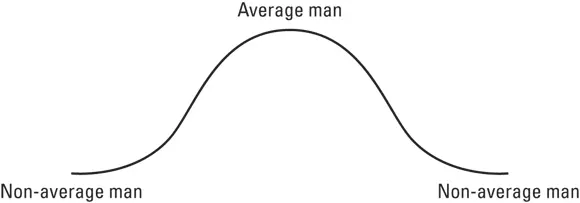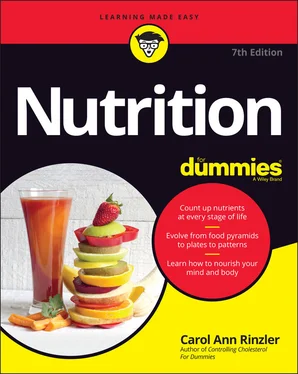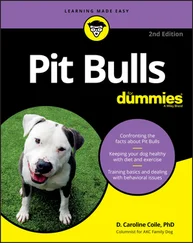These are a pretty good description of how nutritional guidelines need to work, don’t you think?
The BMI: Another way to rate your weight
The body mass index (BMI) is a number that measures the relationship between your weight and your height. Currently in the United States, a BMI below 18.5 is considered underweight, 18.5 to 24.9 is normal, 25.0 to 29.9 is overweight, 30.0 to 39.9 is obese, and 40.00 or greater is severely obese. Previously, other countries were slightly more lenient in their estimate of normal and overweight; for example, in Australia, a BMI of less than 20 was considered underweight. Today, the American standards are generally accepted around the world.
The equation used to calculate your BMI is called the Quetelet Index, named after the 19th-century Belgian mathematician and astronomer who invented the concept of “the average man” (see the nearby sidebar “The man who invented the average man”). The equation is W/H 2, which originally meant weight (in kilograms) divided by height (in meters, squared). The American equation, however, divides your weight in pounds by your height in inches, squared. So if you are five foot three inches tall and weigh 138 pounds, the U.S. equation looks like this:
BMI = W/H2 x 705= (138 pounds/63 x 63 inches) x 705= (138/3,969) x 705= 24.5 BMI
THE MAN WHO INVENTED THE AVERAGE MAN
Lambert Adolphe Jacques Quetelet (1795–1874) was a Belgian mathematician, astronomer, statistician, and sociologist who invented the concept of the homme moyen (middle man), the average Joe who stands at the center of any bell curve.
Quetelet's main concern was predicting criminal behavior. To this end, he hoped to develop statistical patterns based on a person’s deviation from average (read: normal) social behavior that could be used to predict his actions, including moral (good) and criminal (bad) behavior. Although this idea provoked many lively discussions among 19th-century social scientists, it never really worked as a crime-fighting tool. But it is extremely useful in estimating health risks.
(Figure adapted from Clinical Guidelines on the Identification, Evaluation, and Treatment of Overweight and Obesity in Adults: The Evidence Report.)

For a simpler solution, go to www.nhlbi.nih.gov/health/educational/lose_wt/BMI/bmicalc.htm , fill in the numbers, and bingo! The Baylor College of Medicine has an even niftier calculator site that gives you BMI plus the daily calorie intake that keeps you where you are or what you need to lose a few pounds. Check it out at www.bcm.edu/cnrc-apps/caloriesneed.cfm/TheBaylorCollegeofMedicine%20Calorie%20Needs%20and%20BMI%20calculator .
Or you could just run your finger down the screen showing the National Institute of Health’s BMI chart for men and women from four feet ten inches to six feet four inches tall, weighing 91 to 443 pounds with “normal” being within a pound or two of the healthful weights proposed for younger people in the 1990 Dietary Guidelines for Americans. You can find the chart at https://www.nhlbi.nih.gov/health/educational/lose_wt/BMI/bmi_tbl.pdf .
A tape measure or a weight chart is a low-tech tool anyone can handle. But science loves complexity, so weight experts have several complicated ways to figure out if you’re fat. Here are three of the most interesting. Warning: These are not your handy home tests — they’re performed in some doctor’s office but more likely in a research hospital or bariatric clinic.
Bioelectric impedance: Your body is full of fluids packed with electrolytes, such as sodium and potassium , ions that conduct the electrical impulses that send messages back and forth among your cells. Muscle tissue contains more fluid than fat tissue, so a body with more muscle than fat is less resistant to an outside electrical current. To measure your body's resistance to electrical current (a phenomenon known as impedance ), the technician conducting the test places electrodes at your wrists and ankles and zaps a harmless low-intensity electrical current through your body. Then she calculates how resistant your tissues were to the current. The final number indicates how much body fat you have.
The BOD POD: This egg-shape chamber measures how much air you displace when you step in. Because muscle is denser tissue than body fat and displaces more air, the tech running the test can calculate the amount of fat in your body by looking at your weight and then at the amount of air you push aside when you enter the chamber.
Dual-energy X-ray absorptiometry (DEXA): This test uses X-rays to measure muscle, bone, and body fat. The test — which takes about ten minutes — produces an image of the tissues that allows the tech to estimate the amount of body fat.
Understanding What the Numbers Really Mean
Weight charts, tables, numbers, and stats are so plentiful that you may think they’re totally reliable in predicting who’s healthy and who’s not. They aren’t. Real people and their real differences keep sneaking into the equation.
For example, BMI is not a reliable guide for
Women who are pregnant or nursing
People who are very tall or very short
Professional athletes or weight trainers with very well-developed muscle tissue. Remember: Muscle weighs more than fat, so a person with lots of muscle tissue may have a higher BMI and still be really healthy.
In addition, the value of the BMI in predicting your risk of illness appears to be tied to your age. If you’re in your 30s, a lower BMI is clearly linked to better health. If you’re in your 70s or older, no convincing evidence points to your weight playing a significant role in determining how healthy you are or how much longer you’ll live. In between, from age 30 to age 74, the relationship between your BMI and your health is, well, in between — more important early on, less important later in life.
Increasing the odds of accuracy
To make the BMI a more accurate tool for predicting the health risks of carrying extra weight, the National Institutes of Health suggests adding a second measurement, the waist circumference — in other words, the apple/pear test.
An apple is a body with lots of fat around the middle: your waist. A pear has fat around the hips and thighs. Apples have a higher risk of diabetes, high blood pressure, and heart disease.
To identify your body type, wrap a measuring tape around your middle, just above your hip bones. Take a deep breath. Let it out. See what the tape says. That’s your waist.
Table 4-4shows the relative risks of Type 2 diabetes, hypertension, and heart disease associated with different waist measurements.
Seeing red flags on weight and health
No one factor, such as weight, gives a complete picture of how healthy — or unhealthy — you are. Regardless of your BMI or any other measurement, the risk of health problems rises if you have more than one other common problem. Here is a sample list:
High blood pressure
High levels of LDL (“bad”) cholesterol
Low levels of HDL (“good”) cholesterol
High levels of triglycerides (a kind of fat found in blood) TABLE 4-4Estimated Risk Linked to BMI and Waist SizeBMI categoryRisk at Waist size <40 Inches (Men), <35 Inches (Women)Risk at Waist Size >40 Inches (Men), >35 Inches (Women)Underweight<18.5——Normal19–24.9——Overweight25–29.9IncreasedHighObese30–34.9HighVery high35–39.9Very highVery high>40Extremely highExtremely high National Heart, Lung and Blood Institute, National Institutes of Health, www.nhlbi.nih.gov/health/public/heart/obesity/lose_wt/bmi_dis.htm
Читать дальше













